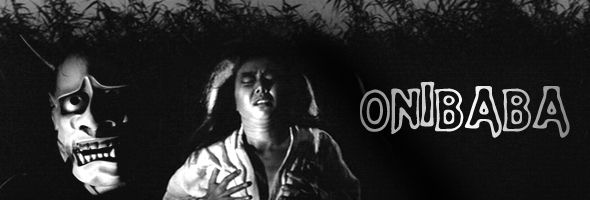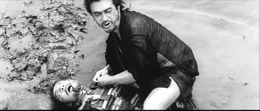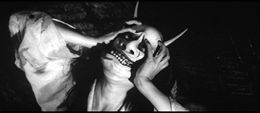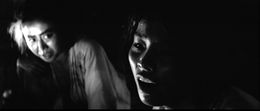
B&W, 1964, 103m. / Directed by Kaneto Shindō / Starring Nobuko Otowa, Jitsuko Yoshimura / Criterion (US R1 NTSC), Asmik Ace (Japan R2 NTSC) / WS (2.35:1) (16:9), Filmax (Spain R2 PAL) / WS (2.35:1)
When two fleeing warriors struggle through a grassy field, they are ambushed by a murderous pair of women, the middle-aged matriarch (Otowa) and her daughter-in-law (Yoshimura), whose husband is off at war. The women strip their victims of their armor and possessions, dumping the bodies into a deep pit and selling off the goods for food. One day soldier Hachi (Kei Sato) arrives with news of the missing son/husband's death; he soon learns of the women's scheme and agrees to join them while repeatedly attempting to seduce the perpetually perspiring young widow. Otowa is afraid of being abandoned by the potential lovers and comes upon a unique plan for self-preservation; one night she leads a demon-masked general to his doom in the pit, then absconds with the frightening mask to use as a tool for frightening the young woman into obedience. However, all does not work out as planned.
Crammed with fascinating symbolism, Onibaba is one of the darkest "spicy" films of its era; bare skin and unchecked libidos run rampant, but few will find
A thoroughly chilling parable, the unforgettable Onibaba became one of the most widely discussed and successful non-Kurosawa Japanese cinematic exports during the 1960s, competing with the similarly themed Woman in the Dunes as the pinnacle of Asian art house psychosexual studies. Though ostensibly a period piece unfolding during a medieval clash between two warring shogunate forces,
 the film strives for universal meaning by depriving its two main characters of names and telling its story as a macabre, adult fairy tale, complete with a wicked mother figure and a not-so-charming prince.
the film strives for universal meaning by depriving its two main characters of names and telling its story as a macabre, adult fairy tale, complete with a wicked mother figure and a not-so-charming prince.
 the prospect appealing when it all leads back to "the hole," a dank pit filled with bones and debris. Whether representing the inescapable blackness within the human soul or perhaps something more Freudian, the hole extends to the very texture of the film as the scope frame is filled with a suffocating blackness, relieved only by the occasional daylight scenes in which landscapes of windblown grass swallows up figures living and dead. Nowhere outside of Night of the Hunter can one find a more remarkable use of multi-plane photography juxtaposing characters and landscape as stylized elements, with silhouettes often leaving the viewer struggling to make out details as the world seems to be descending into perpetual night. The mask itself is a chilling image and used to excellent effect; the sight of Otowa crouching in the darkness, hands clawed out, is not easily forgotten, and the howling, enigmatic finale seems designed to leave viewers debating long after leaving the theater. Also notable is the striking music score, a mixture of traditional percussion and experimental jazz that oddly never seems to break the period atmosphere.
the prospect appealing when it all leads back to "the hole," a dank pit filled with bones and debris. Whether representing the inescapable blackness within the human soul or perhaps something more Freudian, the hole extends to the very texture of the film as the scope frame is filled with a suffocating blackness, relieved only by the occasional daylight scenes in which landscapes of windblown grass swallows up figures living and dead. Nowhere outside of Night of the Hunter can one find a more remarkable use of multi-plane photography juxtaposing characters and landscape as stylized elements, with silhouettes often leaving the viewer struggling to make out details as the world seems to be descending into perpetual night. The mask itself is a chilling image and used to excellent effect; the sight of Otowa crouching in the darkness, hands clawed out, is not easily forgotten, and the howling, enigmatic finale seems designed to leave viewers debating long after leaving the theater. Also notable is the striking music score, a mixture of traditional percussion and experimental jazz that oddly never seems to break the period atmosphere.
 Criterion's DVD significantly improves on their previous widescreen laserdisc both in terms of transfer and extras. The anamorphic presentation looks wonderful, with deep, saturated blacks and none of the film-related flaws present in earlier video versions. The chiaroscuro lighting inside the women's hut is conveyed wonderfully, and the disc encoding even handles the potentially tricky field scenes with excellent fidelity. An earlier Japanese DVD (without subtitles) contained a 40-minute documentary, but the Criterion disc splits some of the same material into two new supplements. A 20-minute video interview with director Kaneto Shindo covers the story of the film's production, from the unorthodox score to the conditions of studio filmmaking at the time. His comments are interspersed with behind-the-scenes Super 8 footage shot during the making of the film, including some fascinating color shots of the actors at work. A separate behind-the-scenes reel presents the rest of the footage, shot by Sato, all silent and primarily black and white except for a few color minutes at the end. Also included are a theatrical trailer (in raw form without text), a stills gallery including conceptual and production art, a translation of the Buddhist fable which loosely inspired the film, and a written statement from the director.
Criterion's DVD significantly improves on their previous widescreen laserdisc both in terms of transfer and extras. The anamorphic presentation looks wonderful, with deep, saturated blacks and none of the film-related flaws present in earlier video versions. The chiaroscuro lighting inside the women's hut is conveyed wonderfully, and the disc encoding even handles the potentially tricky field scenes with excellent fidelity. An earlier Japanese DVD (without subtitles) contained a 40-minute documentary, but the Criterion disc splits some of the same material into two new supplements. A 20-minute video interview with director Kaneto Shindo covers the story of the film's production, from the unorthodox score to the conditions of studio filmmaking at the time. His comments are interspersed with behind-the-scenes Super 8 footage shot during the making of the film, including some fascinating color shots of the actors at work. A separate behind-the-scenes reel presents the rest of the footage, shot by Sato, all silent and primarily black and white except for a few color minutes at the end. Also included are a theatrical trailer (in raw form without text), a stills gallery including conceptual and production art, a translation of the Buddhist fable which loosely inspired the film, and a written statement from the director.
